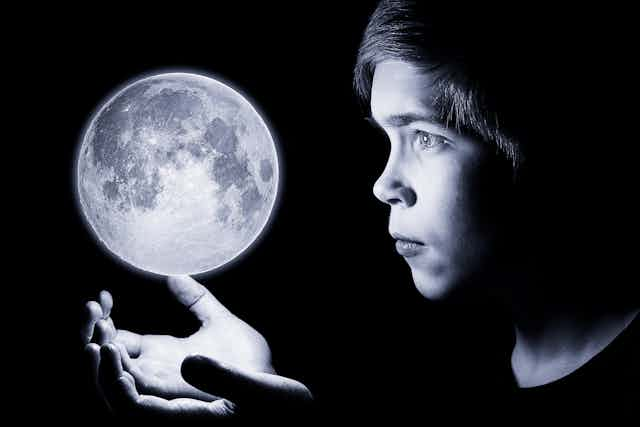Sunday marks the 45th anniversary of the Apollo 11 moon landing on July 20, 1969, after multiple Apollo lunar missions unfolded through the 1960s in front of an awestruck global audience.
But many wondered if the eternal mystique of the moon could survive the onslaught of cold, hard science.
What would lovers do if gazing at the night sky made them think of rockets instead of romance? Would humanity lose something precious by taking technology into the realm of myths and legends?
How perceptions of the moon changed can be mapped through the pages of popular magazines. The Australian Women’s Weekly, for example, published numerous stories, columns and poetry about the moon, as we see below.
By the light of the silvery moon

In the 1930s, poems celebrating the moon as mysterious and feminine were common. This one is by Leona Lee in 1936:
The moon she is a wondrous moon,
Tonight we saw her rise
Above the rim of hills and trees
(Seen thus, of course, through lovers’ eyes)
Dark earth threw off her tired cloak,
And on her shoulders, breast and eyes
The silver moon spilled magic charms,
And looking down romantic wise
She found me in your loving arms.
By 1946, after World War II, science (and satire) started to creep into the poems. In this excerpt from Australian poet and war correspondent Dorothy Drain, the moon laments that he’s had to neglect the lovers, poets and songwriters because of increased scientific interest:
Kindly tell the scientists
I am overworked
And wish
They would leave me alone with my craters.
Goodbye, romantic moon
At this time, the USA, France, Russia and the UK were developing rockets for space launch, and the Cold War was heating up. Australia was in the “Space Club” too, collaborating with the UK at the Woomera launch site in the South Australian desert.
In 1957, the USSR succeeded in launching the world’s first satellite, Sputnik 1, into Earth orbit. Not only was this the beginning of the contemporary satellite industry, but it fostered greater ambitions. An unknown author opined:
Now that the Russians have sputniked the world, practically everyone is talking about not satellites, but of the moon as the next step.
The prospect brought science and culture face-to-face: “Goodbye, romantic moon,” lamented the same writer. “Poor lovers: it’s black, hot and full of dust.”

Science had shown the perfect pearly light, which bestowed ethereal beauty and inspired contemplations of the ineffable, to be a sham.
And it got worse:
For how will lovers be able to gaze uninhibited at the moon, without shrinking into the shrubbery and whispering “Big Brother will be up there any moment”?
This image recast the moon from the keeper to the betrayer of lovers’ secrets - if the Russians got there first. (Needless to say, this Big Brother is a reference to George Orwell’s totalitarian state in the novel 1984, not the later genre of reality television.)
After the Apollo 8 lunar orbit returned close-up images in January 1968, the Weekly’s columnist Robin Adair wrote about how old ideas of the moon would have to be abandoned:
As one music magnate remarked, “What the heck do I do with records and sheet music that go ‘Blue Moon, I saw you standing alone …’” when Astronaut Lovell said, in effect, “Moon, I saw you standing below, a whitish grey, like dirty beach sand …?”
With this comparison, “a thousand poets turned in their graves” according to journalist Kay Keavney.

Adair was scathing of a US group called Hands off the Moon, who wished to keep the moon pristine as a romantic symbol. He admitted, though, “that it will rather take the mystery and glamour out of the old moon when blokes have roamed around it”.
The two cultures
All of this tongue-in-cheek banter concealed a serious concern. The tension between the moon of science and the moon of romance was captured by chemist and writer CP Snow in his influential 1956 essay The Two Cultures. Snow argued that science was in the ascendancy, but that neither the sciences nor the traditional culture of literature and art had a proper understanding of each other, to the detriment of both.
In many ways, the moon was the battleground not only of communist and capitalist Cold War ideologies, but for which of the two cultures would write the script for the universe.
By May 1969, the confrontation was imminent. “In a few weeks,” proclaimed a headline, “purple [science] fiction will be changed to prosaic fact when men land on the moon”.
And with one small step, neither the moon nor the Earth was ever the same again.
Was Apollo 11 the end of the lovers’ moon? It seems not. People found a way to reconcile the dissonance between the two cultures in their everyday lives. No doubt many looked up at the moon in the weeks that followed, wonderingly, and came to the same conclusion as Australian writer Nan Musgrove, who wrote on August 6, 1969:
It looked so ugly in those pockmarked cratered pictures taken by Apollo 11. But on Sunday night in the sky it was as lovely as ever, caught up in a halo showing through the overcast.
One did not have to choose which moon to keep; science and the arts had not been riven fatally apart by the encounter with reality. Perhaps, on the contrary, it had brought them closer together.
Epilogue
On July 20, 1969, humans set foot on another world for the first time. Less than four years later, on December 14, 1972, the Apollo 17 astronauts left the moon and no one has been back since. If anything, the fleeting human presence has made us long for it even more.
And as usual, it is the poets who express this longing best:
never land
hold on tight
these are the final strings
from us to there.
(Tycho Girl, 2014)


